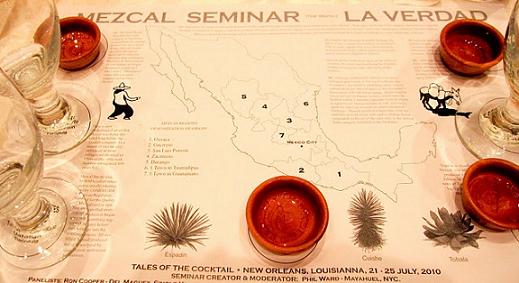There’s mezcal and there’s Del Maguey. You may have heard me talk about Del Maguey mezcals and the line’s founder, Ron Cooper, in the past. A session with the gentle yet passionate Ron (like his mezcal seminar at 2010 Tales of the Cocktail) is an experience you’re not likely to soon forget. Even the way he describes fermentation stays with you: “wild creatures eating sugar, farting carbon dioxide, pissing alcohol!”
I’m leaving for Mexico next week, so sipping Del Maguey was getting me in the south of the border mood — even though I’m going to Tequila vs. Oaxaca, where most mezcal is produced. For the unfamiliar, mezcal is a spirit made from the heart (piña) of the maguey, an agave plant native to Mexico. Piñas are roasted underground, giving mezcal its distinctive smoky properties. Mezcal is the peaty scotch of tequila, which by definition is a mezcal made specifically from blue agave in Tequila, Mexico.
One thing I learned in Ron’s seminar is that traditionally, mezcal was rarely oak-aged for any length of time — more aged mezcals are being produced purely to gain in competing markets. Similar to tequila, mezcal styles include joven (literally “young,” and in this case referring to a silver liquor); blanco (white), which must be bottled within 2 months; reposado (rested), which ages 2-12 months in oak; anejo (mellow), aged a minimum of 1 year in oak; and the rare Pechuga (chicken breast), which can be triple-distilled with everything from fruits, nuts, white rice, to, yes, chicken.
Mezcal is usually drunk neat and you’ll find many in the Del Maguey line available by the shot at Nopalito. Places like Oakland’s Tamarindo Antojeria, with their new tequila bar, Miel, serve cocktails like the Mezcalito – ($12) with Del Maguey’s Creme de Mezcal, fresh orange and volcanic salt rim.
I’ve had the privilege of tasting most Del Maguey mezcals, each one a revelation. Here’s a few recommendations (available locally at Cask and K&L Wine Merchants):
Chichicapa, ($69.99) – After multiple tastings, this may be my favorite for all-around balance. It marries the best elements of smooth smokiness with citrus. Despite a surprisingly light nose, there’s spice, chocolate, even mint on the finish. It reminds me of a fine coffee mole: succulent, spiced, earthy.
Crema de Mezcal ($39.99) – One of the more affordable in the line, this single village mezcal is made from unfermented agave syrup collected during roasting and exhibits a smoky, earthy sweetness with creamy texture. Works as a great introduction to mezcal for the uninitiated.
Mezcal Vida ($38.99) – Newer in the line, the Vida is another fine intro to mezcal: a pure, straightforward expression. Produced according to 400-year tradition with nothing but the agave heart and water, it’s bright with notes of fruit and sweet grass.
Tobala ($119.99) – Tobalá is a sophisticated level of mezcal, taking around eight Tobala piñas (hearts) to equal one piña from the most common maguey plants. Though fruity on the nose, the taste is elemental… smoke intermingles with tropical fruits and dusty cinnamon, with a long, smooth finish.
Minero ($69.99) – From the tiny village of Santa Catarina Minas, this mezcal is double-distilled, giving it greater smoothness with a floral essence tasting of warm honey and fig.
Santo Domingo Albarradas ($69.99) – Citrus and roasted pear combine with wood for a clean, dry mouth feel.
San Luis del Rio ($79.99) – Spice, fruit and ubiquitous smoke hit you on the nose, but there’s mineral citrus and volcanic earth inherent in this recent release produced two hours south of Oaxaca.
Pechuga ($200.00) – Pechuga starts with a double-distilled Minero base, to which 25 pounds of wild mountain apples, plums, red plantain bananas, pineapples, almonds and a few pounds of uncooked white rice are added to each 75 liters of mezcal for distillation round three. Though there is no taste of chicken, a whole chicken breast (minus the skin) has its excess oil removed while cleaned in water, then is hung over the still for a day while spirituous vapors condense into a clear liquid that drips from the bird into the mezcal. With intense citrus on the nose, this fruity spirit evokes earth but is a bright counterpart to the smoky, rocky soil of other mezcals. All that fruit imparts a robust fall glow by way of a gentle spring.
Subscribe to Virgina’s twice-monthly newsletter on SF’s hottest tastes and tipples, The Perfect Spot

